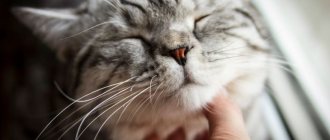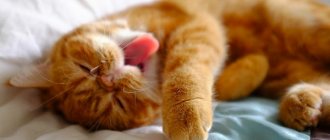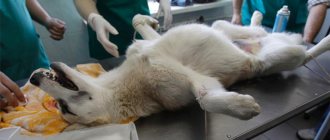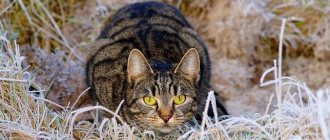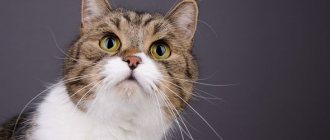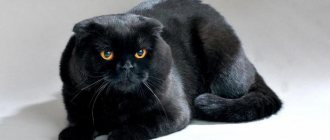Purring is a quiet and prolonged vibration emitted by some representatives of the cat family. Many people attribute healing properties to this ability. It is put on a par with the sound of rain, the crackle of a fire and other pleasant and relaxing sounds. Felinologists are still trying to figure out how and why cats purr, and ordinary people have long figured out which breeds are considered the most “talkative.”
For what reasons does a cat purr?
When answering why cats purr, many owners confidently say that the reason lies in positive emotions. This answer is correct, but incomplete. Sometimes purring is also triggered by negative emotions. You can only understand your pet's desires over time by remembering the difference in volume, duration and frequency of sounds.
Positive emotions
The ability to make a vibrating sound appears in kittens on the 2nd day after birth.
This is necessary to communicate with the mother. The purring of the babies indicates their satiety and good health, and the sounds emanating from the mother cat confirm the safety of her offspring.
In the wild, light vibrations are not detected by other predators, but are clearly perceptible to parents located at a long distance. This helps protect the litter until it becomes independent.
Among the positive emotions that awaken purring are:
- greeting the owner or communicating with other animals;
- going to bed before bed;
- gratitude for the treat or affection received;
- attracting the opposite sex;
- trying to beg for something tasty;
- interest in some object (delicious food) or object (a bird outside the window).
According to one version, cats purr to prevent muscle diseases that threaten them due to too much sleep. Vibrations spreading throughout the body have a positive effect on ligaments, bones and muscles, helping to reduce the load on the musculoskeletal system.
Negative emotions
Purring also occurs when a furry pet is under stress. The vibrations help him stabilize his blood pressure and bring his pulse back to normal.
Sometimes the reason lies in illness. Purring is a physiological pain reliever. It speeds up metabolism and promotes rapid regeneration. Try to observe how a cat purrs after sterilization: the frequency and volume of the sound will differ from usual until the end of rehabilitation.
One of the possible complications of coronavirus infection is feline infectious peritonitis. Its alternative name is “purring disease.” Due to damage to the blood vessels, some of the fluid enters the peritoneum and lungs, causing peritonitis. The bloating that appears is accompanied by a characteristic purring sound.
Also, mustachioed pets purr when their owner strokes them incorrectly or when a more formidable opponent tries to scare them. In the second case, they demonstrate their defenselessness, trying to avoid a possible fight.
Interesting facts about purring
Despite the fact that similar sounds can be made by animals such as foxes, raccoons, mongooses, and bears, when talking about purring, they traditionally mean the cat family.
- A new record has been entered into the Guinness Book of Records. A cat named Merlin is considered the loudest purr on the planet.
- Among cats, there are those that can both purr and meow. This helps them when communicating not only with each other, but also with people. Zoologists about cats have analogues of some sounds pronounced by people: M, N, R, V, X, G, F.
- While an animal is purring, it is impossible to listen to its heart and lungs, so many veterinarians turn on the water when examining an animal. The sound of pouring water silences the cat.
- Pets make sounds either completely alone or in the presence of the owner. If two pets are in the same room, they will never “talk” to each other.
- Facts have been scientifically recorded when animals that lived for a long time next to people imitated entire words.
- Purring has an amazing effect not only on cats, but also on people who hold them in their arms. The frequency of the sound wave varies smoothly from 25 Hz to 150 Hz. This has a beneficial effect on the human circulatory system and has a calming effect.
How the purring mechanism is started
Scientists do not fully understand how cats purr. The vocal cords are responsible for the sound, but vibration is explained by more interesting reasons.
Physiological features
The most popular theory to explain how cats purr is the one that focuses on the hyoid bones. In domestic animals they take the shape of a triangle, and in wild animals they take the shape of a rectangle. Because of this, wild feline predators are rarely found purring.
Everything is easier with sound. It passes through the animal's nose and mouth. The heart and lungs at this moment cannot be listened to.
What is known for certain about vibrations is that they appear based on a signal from the brain. When receiving positive and negative emotions, it sends neurons to the responsible organ. This helps to guess what cats purr about.
Unproven facts
When discussing how cats purr from a physiological point of view, we take as a basis the muscles located behind the vocal cords. Their contraction leads to vibration of the hyoid bones, spreading throughout the body. This theory is the most popular, but there are several others. They explain that purring occurs through:
- Lungs
. A purring pet is the result of the work of the diaphragmatic and intercostal muscles. It is assumed that during the breathing process they create sound vibrations of different amplitudes. This is the least popular theory, since the intensity of the purring does not change with inhalation and exhalation.
- False ligaments
. They are located directly above the vocal cords and look like a bunch of elastic membranes. According to this theory, sound vibrations appear due to changes in pressure in the circulating bloodstream. This causes the chest to vibrate and transmit sound to the sinuses.
The hyoid bone theory is more convincing. This is confirmed by the absence of purring in cats with laryngeal paralysis.
Purring as a means of communication for cats
Purring sounds help cats communicate with each other, warn about something or report. If a cat purrs quietly, this may mean that she has a friendly attitude, she is calm and friendly. A loud purr indicates the dominance of this cat over its relatives. This is how she shows a weaker opponent that there is no point in fighting with her and the weaker cat does not have to worry about a possible attack. Purring can also mean that the cat is completely defenseless and asks you not to attack it.
It is interesting to watch the relationship between mother cat and kittens. Cubs can purr if they are hungry or, on the contrary, if they are full and do not need feeding. They also purr when they are satiated with their mother's milk with pleasure. The mother cat herself purrs, letting the kittens know that they are safe and under her protection. For example, when she purrs as she approaches the kittens, she makes it clear that mom is already close and they don’t have to worry about anything.
The amazing thing is that cats can heal each other by purring. So, if one cat feels bad, the second one can come up, lie down next to him and purr, encouraging him and calming him down.
Which other member of the cat family can purr?
Once you understand how cats purr, it is not so difficult to understand which of their wild relatives is capable of emitting similar sound vibrations. Large cats differ not only in the shape of the hyoid bone, but also in the elasticity of the ligaments. Only the group of small cats has the most flexibility: cheetahs, ocelots and lynxes; they can make purring sounds.
Despite physiology, there are exceptions. Purring large predators include snow leopards, pumas, clouded leopards and leopards. Given the structure of the larynx, their ability is a real mystery.
why does a 4 month old cat purr very loudly at night?
My cat is very affectionate, funny and smart. to go to bed, my beloved Murzik, as usual, also lies down on the pillow next to me, purring loudly.
We recommend reading: Diseases of Chicken Scabbers Legs Photo
The cat is tired of purring loudly at night. Anna Sidorenko Expert (275), voted 2 years ago
| —>Total comments: 5 | |
| Why do cats purr and why do they do it? Every owner is touched by the sight of a contented, purring cat. Moreover, only representatives of this family can make such sounds, and no one else. Why do cats purr? There are several versions that can explain this phenomenon. | |
Cat-human interaction
The way a cat purrs depends on the person. A purring pet can trample its paws on its owner, lie down on top or next to it. All these actions have their explanation.
Showing affection
If you stroke your mustachioed pet, he will soon begin to purr. This means that he enjoys touch and communication with a person. When stroking against the grain or by a stranger, you can see the opposite effect. The animal will be angry or frightened and will hasten to leave with a threatening hiss.
Foot trampling
The most popular interpretation of trampling is the “milk step”. Kittens make similar movements on their mother's chest, stimulating the faster production of milk. Fingering with paws is also associated with:
- showing gratitude and demonstrating trust in a person;
- unrealized sexual instinct in castrated animals;
- treating the owner or relieving one’s own stress;
- preparing a comfortable place to sleep.
If your pet releases its claws when trampling, do not scold it. He does not control this action, so pet him and place a thick blanket or pillow under his paws.
Lying on or next to a person
Lying nearby is the highest form of trust and love. The animal feels safe with its two-legged owner. If a person is unwell, a furry pet can lie on top, sending its healing vibrations to the sore spot.
Cat “massage” with paws
There are various reasons why an animal gives its owner such a massage. Pets especially love to lie on the chest or gently stomp on it with their paws. There are several reasons why cats trample with their paws. The researchers explain this as follows:
- Childhood memories. Kittens often knead their mother when feeding, which brings them peace and pleasure. In adults, this behavior is usually observed after eating or sleeping.
- Preparation for sleep. They often like to sleep on their owner's lap, chest, or stomach. With this massage they seem to trample down the place for this.
- Thanks to the owner. With such movements one says “thank you” for food, warmth, affection, love.
- Medicinal purposes. This is one of the most common reasons for explanation that occurs in everyday life. It is worth knowing that there is no scientific evidence for this and it is a myth.
- Fighting stress. By moving their paws and purring at the same time, cats try to cheer themselves up, relax or calm down.
- Sexual instincts. According to one theory, such behavior appears when physiological needs are not fulfilled. This massage has an unambiguous meaning.
Good to know: why cats need scratching posts and how to choose the right one.
Cats may also mark their territory. On the paws there are special glands that secrete secretions. So it shows that this object belongs to him. This behavior is more typical for males. Often a cat massage indicates that it trusts its owner, loves him and shows him his trust in return.
Question to the expert
Should a cat be allowed to trample its owner's paws?
If the pet settles on the owner and makes such movements, it is not recommended to drive it away. Otherwise, contact between the animal and the person will be destroyed, and the pet will no longer trust him. A cat will reflexively pull its claws inward if you gently stroke the top of its paw.
Why don't some cats purr?
Non-purring breeds include Ragdolls and Devon Rex, as well as overly phlegmatic pets. If a healthy cat does not purr, like its relatives, then everything is fine with it. This feature is inherited.
If lethargy, rapid heartbeat, dry nose or shortness of breath appear, the animal should be seen by a doctor. Damage to the “rumbling” occurs in diseases of the respiratory system.
Also, the reason for the lack of purring can be stress or a bad mood of the owner. Relaxing in the arms of a tense person is not so easy.
The cat is constantly yelling. What to do?
It’s not pleasant that your pet is constantly yelling. But what to do in this case? Fight or let it slide? First you need to find out the reason, maybe you will find it after all. In fact, cats have few needs: feed her if she’s hungry, cuddle her if she’s bored, play if she’s in a playful mood. It's nothing big for you, but it means so much to the animal.
On your part, of course, attention and a little patience are required. It just seems that she is indignant constantly and for no reason. They exist, but they are probably not on the surface. Start with yourself; screams and high-pitched meows may be the result of the upbringing that you have instilled in the animal from the age of a kitten. A spoiled pet behaves no better than a spoiled child.
Benefits of “cat songs”
“Cat songs” are useful not only for their authors, but also for listeners. They are helping:
- normalize the emotional state, which is especially useful for owners with nervous disorders;
- strengthen bone tissue and reduce pain;
- improve blood circulation in the brain;
- lower blood pressure or pulse that is too high;
- enhance the regeneration of tissues of the gastrointestinal tract;
- reduce the likelihood of stroke and heart attack.
People who live with furry pets live 4.5 years longer than those who do not have pets. There is also a relationship with allergen resistance. Children who live with a mustachioed pet from birth are less susceptible to respiratory diseases and rarely suffer from asthma.
What is purring?
Perhaps every culture and every civilization has a degree of expediency in its attitude towards this animal. But is it impossible not to notice that in the house where this mysterious beast lives there is some kind of unique atmosphere of comfort and kindness. After all, even today, in the age of mastering high technological techniques, banal cat singing - purring, which our contemporaries so often enjoy, remains a mystery to scientists. It is difficult to argue with the statement of the English writer Prachett, who considered a cat’s purring as a reason to forgive his pet for all mischief and pranks, torn curtains and broken vases. A cat or cat purring is simply an amazing thing.
© shutterstock
Currently, modern science is more or less aware of the specific mechanisms of this sound signal. However, the reasons why cats purr, the meaning and origin of the brain impulse that leads to the fact that a pet cat begins to purr, have not become fully known.
Causes
The first reason is pleasure. Kittens purr from warmth and satiety, adult cats purr from the affection of their owner. Animals show it not only by sound, but also, for example, by releasing their claws.
In addition, there are a number of other factors that can trigger purring:
- Demand for attention.
- Request for food.
- Relieving stress and pain, for example, during childbirth or severe wounds, fear.
- Expression of gratitude.
- Acquaintance.
- The joy of hunting.
Are all cat breeds equally talkative?
Zoologists claim that there are breeds that are hereditarily conditioned to be more “talkative,” and there are others that are the opposite. For example, Cornish Rex, Siamese, and Thai are considered very talkative. Devon Rex and Ragdoll are less talkative. These factors need to be considered before taking a pet into your home.
Regardless, you should enjoy the time you spend with your pet. It’s so nice to pet a purring kitten after an active day. After all, in this way they give us their love and affection.
Comparison of the purring of cheetahs and domestic cats
Scientists comparing the purr of the Cheetah (Acinonyx jubatus) and the domestic cat (Felis catus) found that the former purred at an average frequency of 18.32 Hz to 20.87 Hz, while the much smaller domestic cat purred at an average frequency of 21.98 Hz. Hz to 23.24 Hz.
Researchers studied purring in four domestic cats and found that the fundamental frequency ranged from 23.0 to 26.09 Hz for the input phase and from 20.94 to 27.21 Hz for the output phase. They also observed significant differences between the four cats in the relative amplitude, duration, and frequency between the exit and penetration phases, but this variation occurred within the same general range.
A study of the purring of four adult cheetahs showed that all of them had output phases that were longer than input phases. As in domestic cats, in these animals the frequency of the entry phase was lower than the exit phase. The average ranged from 19.3 to 20.5 Hz for the first and from 21.9 to 23.4 Hz for the second. In addition, the amplitude was higher in the output phases of all four cheetahs.
When the purrs of adult, subdulsive and juvenile cheetahs were compared, it was noted that although there were significant differences in most of the parameters analyzed (amplitude, phase duration, cycles per phase and fundamental frequency), this was mainly due to the degree of relaxation or activity of the animals, resting or playing. Intense phases tended to decrease in frequency, but there were no significant differences in these parameters as a function of age.
The purpose of purring, what your favorite cat wants to say
So, how this sound occurs is known quite approximately. Cat fans may not know that their favorite furry pet makes these amazing sounds at a rate of 25 cycles per minute. The frequency and number of vibrations are always the same; these indicators are not affected by size and breed, gender or age. And again, versions as to why in some situations the pet meows loudly, and in other situations cats move their paws and purr :
- The system is a code of communication between mother and cubs, when the kittens want to tell the cat that they are fed and healthy, everything is calm and the mother can calmly go on a night hunt.
- A state of complete calm and tranquility. A cat lover knows well how an adult purrs when feeding or calming babies, and feels pleasure from the fact that a person caresses her.
- Expressing gratitude for kind words, a good dinner or a favorite treat, scratching and stroking by the hostess or owner. In such situations, the cat purrs and purrs quietly, they literally lie down on the person and purr. How nice it is to hear this rattling sound as a sign of a contented cat’s life, bliss and satiety.
- An emotional state that people identify with classical vocals or amateur singing in the kitchen. With the help of a uniform cyclic sound, which has varying volume and intensity, a cat purrs and expresses its emotions, feelings, and mood.
- The need to restore well-being due to illness or disease. In the process of purring, blood circulation and metabolic processes improve, allowing you to calm down, warm up, and fall asleep after stress.
- Expressing a desire to get to know each other or simply good intentions regarding another cat or cat.
- The desire to refresh yourself with something tasty that the owner can treat you to, the desire to be held or cuddled, to bask in the owner’s bed on cold winter nights.
- Feeling of fear, panic, threat of attack. In this case, purring is an expression of a request to rid the animal of a possible threat. When it passes, the cat may stop purring.
- Internal harmony, especially often a cat purrs in the evening, when soon all the inhabitants of the house are going to sleep. Experts say that the rhythmic sound allows the animal to prepare for sleep, while the work of the lungs and heart slows down. Cats and cats are capable of purring even in superficial sleep, as if lulling themselves.
Among the main versions - the purr can make angry, threatening sounds as a defense of its habitat, food, and bed. As an option, the possibility of manifestations of the hunter's predator instinct is considered. A well-known picture is when a cat sits on the window and watches the frolicking birds, albeit visually, but imitating the hunting process.
© shutterstock
